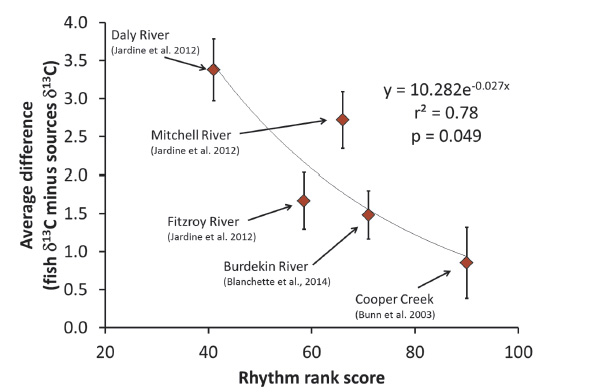
Ecological Archives E096-066-A4
Timothy D. Jardine, Nicholas R. Bond, Michele A. Burford, Mark J. Kennard, Douglas P. Ward, Peter Bayliss, Peter M. Davies, Michael M. Douglas, Stephen K. Hamilton, John M. Melack, Robert J. Naiman, Neil E. Pettit, Bradley J. Pusey, Danielle M. Warfe, and Stuart E. Bunn. 2015. Does flood rhythm drive ecosystem responses in tropical riverscapes? Ecology 96:684–692. http://dx.doi.org/10.1890/14-0991.1
Appendix D. Stable isotope ratios (13C/12C) of carbon (δ13C) for fish and local food sources (benthic invertebrates and periphyton) collected from multiple locations in rivers that vary in rhythmicity.
Fig. D1. The average difference in stable isotope ratios (13C/12C) of carbon (δ13C) between fish and local food sources (benthic invertebrates and periphyton) collected from multiple locations in rivers that vary in rhythmicity. More rhythmic rivers contain fish that have derived their body mass from outside the location of capture (i.e., predictably available floodplains), whereas the δ13C of fish from arrhythmic rivers are closely aligned with local prey, indicating local foraging.
Literature cited
Blanchette, M. L., A. M. Davis, T. D. Jardine, and R. G. Pearson. 2014. Omnivory and opportunism characterise food webs in a large dry-tropics river system. Freshwater Science 33:142–158.
Bunn, S. E., P. M. Davies, and M. Winning. 2003. Sources of organic carbon supporting the food web of an arid zone floodplain river. Freshwater Biology 48:619–635.
Jardine, T. D., N. E. Pettit, D. M. Warfe, B. J. Pusey, D. P. Ward, M. M. Douglas, P. M. Davies, and S. E. Bunn. 2012. Consumer-resource coupling in wet-dry tropical rivers. Journal of Animal Ecology 81:310–322.